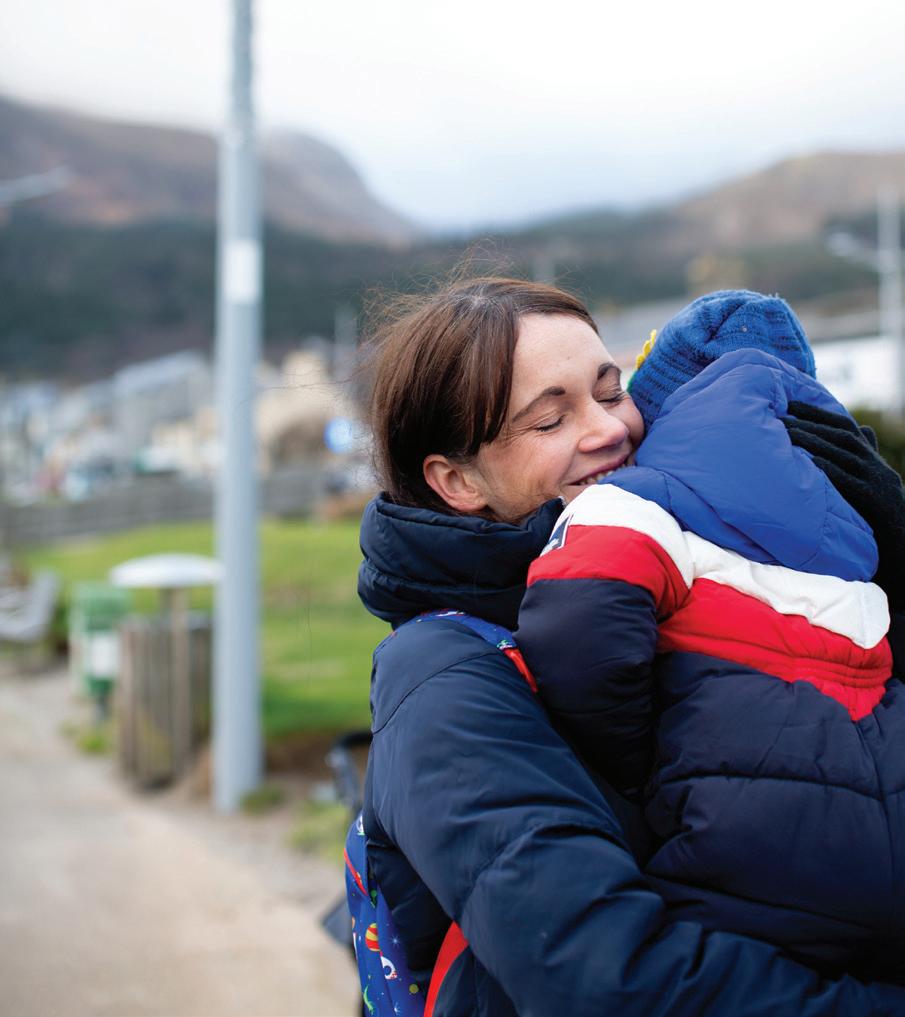
8 minute read
Walking the recovery road
Dr Sharon Hastings, who first wrote an article for the Herald back in February 2020 on her struggles with mental health, now shares her experiences of recovery.
It’s a typical evening.
My son laughs as his bath toy squirts water high in the air. I rinse the shampoo out of his hair. “1-2-3!” I lift him on to his fluffy towel and kiss his cheek.
With baby in bed, I sit down to write a guest blog post. The subject is psychosis and what faith might look like for someone who has lost touch with reality.
At 9pm, I lift a container from the sideboard in the kitchen. One by one, I take out boxes of antidepressants, moodstabilisers and antipsychotics, plus a drug to help treat side effects. Later, I practise some mindfulness and read a devotional, then have a snack with my husband.
Severe mental illness – a life sentence?
Previously, I wrote in this magazine that, “Those of us who live with severe mental illness are unlikely to find healing in the sense of having our symptoms removed completely.”
Ten years ago, I was diagnosed with schizoaffective disorder – a mental illness characterised by episodes of depression, mania and psychosis – and I was told to adjust my expectations of life. I had graduated as a doctor, but my future was likely to involve day centres and volunteering.
More recently, I came across the ‘Recovery Model’ of mental healthcare, which proposes that recovery is not ‘cure’, but “a process of change through which individuals improve their health and wellness, live a self-directed life, and strive to reach their full potential.”
Recovery in this sense is marked by acceptance and change: acceptance of ongoing symptoms and side effects; change in mindset, skills, and choices to make life better in this context. Of course, what we accept is key – I did not accept that I would never work again. I have found Reinhold Niebuhr’s ‘Serenity Prayer’ helpful: “God, grant me the serenity to accept the things I cannot change, the courage to change the things I can, and the wisdom to know the difference.”
My recovery journey…
Today, I am walking in recovery, and I have identified 10 steps in the process which has brought me this far:
1. A foundation: I couldn’t just ‘pull myself out’ of my psychotic depression; I needed professional help to kickstart the recovery process. Early in 2019, I met a new psychiatrist who changed my medication, finding a combination which was tolerable and effective. This was the foundation I needed to build upon.
2. A plan: Medication set me on the right path, but I had lost confidence and life skills, and I needed to plan for the future. In the Recovery Model, a longterm ‘therapeutic relationship’ is key, and Christian counselling helped to cement my progress.
3. A book launch: After launching my memoir, Wrestling With My Thoughts, my challenge was to live up to what I had written. I needed to show my mental health team that I was truly drawing strength from God.
4. A steadfast commitment: I became pregnant earlier than expected in my recovery journey. If I was going to parent our child, I needed to take recovery very seriously indeed. If things got tough, walking away would no longer be an option.
5. A rigorous theology: While pregnant, I studied Old and New Testament Survey courses, and read the entire Bible in three months, growing in awe of God and respect for him. I wanted to know him completely and recover in light of his promises and his holiness.
6. A narrower focus: I had spent years chasing career moves to try to get myself better; recovery would mean finding focus, first on motherhood and family life, secondly on my emerging ministry as a writer. I needed to commit to the things which I valued the most.
7. A simple approach: I had sometimes been lazy about the simple things that help me to stay well, such as having a regular routine, getting daily fresh air and exercise, meditating, and spending time with God. Now I determined to maintain good rhythms of living.
8. A personal solution: I wanted to take personal responsibility for my own wellbeing, rather than relying on my professionals to find solutions for me. I studied Dialectical Behavioural Therapy (DBT) through a free online course and have begun to put its principles for mindful living into daily practice.
9. Prayer: Instead of moment-tomoment ‘arrow prayers’, I started praying flat out for recovery and that I would honour God on my recovery journey. I also recruited prayer partners, and a WhatsApp support group was born.
10. A partnership: I needed to be vulnerable enough to seek support and accountability from my church. This was hard, but it was worth it. Our family was hugely blessed by church members who committed to us, and we couldn’t have raised our little one without their practical help and fellowship.
The ultimate recovery
Recovery on earth is not the same as ‘cure’; it involves perseverance through depressive blips and drug side effects. Recovery in heaven will be complete: I will be truly well, free of depression, free from side effects, with no more crying and no more tears.
Why do I tell my ‘recovery story’, and why do I think the Recovery Model is relevant to the church? For the following reasons:
A lesson: As Christians, we are all in recovery from something, at the very least the sinfulness which created our need for salvation. We live in ‘the now and the not yet’ of the kingdom. Now, we need to take up our crosses daily, choosing ‘recovery’ in our life as Christians, while acknowledging that this is not yet the same as ‘cure’, or perfect Christ-likeness. What the Recovery Model teaches is that we don’t have to wait until we are made perfect to live as though we are becoming perfect. Every choice matters and every day we can do positive things which help us build for a future of greater wholeness. I have learnt in recovery that I do not have to wait until life is perfect before I “continue to do good” (1 Peter 4:19).
An opportunity: The Recovery Model recognises that ‘spirituality’ such as having a Christian faith is something to be harnessed as a positive force within the life of someone moving towards recovery… so the church is no longer left to watch and wait while professionals change medications or plan talking therapies. Recovery Model psychologists talk about ‘banking up’ positive experiences to build resilience and help diminish the impact of negative experiences, and Christians can help with this. It might be as simple as taking someone for a walk at a beauty spot, bringing them to a musical event, or having a coffee with them after a church service. As I invest in the good things in life, the ongoing symptoms of illness have less power.
A promise of hope: I believe that King David understood the Recovery Model of acceptance and change millennia before psychologists embraced it. The title of my book comes from Psalm 13, where he wrote, “How long must I wrestle with my thoughts and day after day have sorrow in my heart?” David knew the pain of depression. Yet, while he was still depressed, he prayed, “I trust in your unfailing love…for you have been good to me.” He was not cured, but he knew that God was faithful. With the Recovery Model, there is hope for people with severe mental illness who might at one time have faced a life of institutionalisation and limitation. As Christians, we know that there is hope for all people in this life, regardless of the extent of their previous sinfulness. What’s more, they can look forward to a true ‘cure’ in eternity with Christ. In one sense, my mental health professionals were right: I have never been able to practise as a doctor, but I use my medical training every day as I write, and I have an even more fulfilling role in life as a wife and mum. With the right choices and the right support, recovery is possible. Let’s learn our lessons from the Recovery Model, embrace new opportunities to be involved in the journeys of people with severe mental illness, and share our kingdom hope today.

Photos: Jamie Trimble


